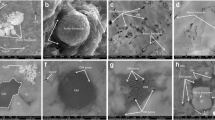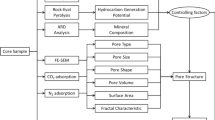Abstract
In order to explore the reservoir characteristics of shallow shale gas reservoir in Zhaotong and its differences with other shale gas blocks in Sichuan Basin, the pore structure of Zhaotong shale gas reservoir was comprehensively studied by various means, including X -ray diffraction, gas adsorption (CO2, N2), NMR, and field emission-scanning electron microscopy. In addition, the adsorption capacity of samples in this area was measured by volume method and the main controlling factors were analyzed. The results show that the shale reservoir in the Zhaotong demonstration area is dominated by clay and quartz minerals, with an average content of 23.1% and 34.3%, respectively. Pore-size distribution is concentrated in the range of 0.5–1000 nm, with micropore and mesopore as the main body. Scanning electron microscopy shows that the reservoir space types are mainly organic pores, intergranular pores, intragranular pores, and microfractures. Among them, organic pores are the most developed and most of them appear in large area network structures with good connectivity. The results of the methane isothermal adsorption test show that the adsorption capacity of shale in the Zhaotong area is positively correlated with TOC content, specific surface area, and micropore volume (\(D \le 10\)nm), but poorly correlated with total pore volume. Due to the influence of mineral types and genesis, the adsorption capacity of shale in this area is negatively correlated with clay content and poorly correlated with quartz content. Through data comparison and analysis, the adsorption capacity of shale in the Zhaotong area is higher than that in the Fuling and Changning–Weiyuan areas. Additionally, due to the influence of mineral genesis, the changing trend of shale adsorption capacity with quartz content is also different in different regions.




















Similar content being viewed by others
References
Aringhieri R (2004) Nanoporosity characteristics of some natural clay minerals and soils. Clays Clay Miner 52(6):700–704
Bai ZQ (2015) Shale characteristics of Wufeng-Longmaxi formations in southwest Sichuan Basin. Chengdu University of Technology.
Barrett EP, Joyner LG, Halenda PP (1951) The determination of pore volume and area distributions in porous substances. I. Computations from nitrogen isotherms. J Am Chem Soc 73(1):373–380
Brunauer S, Emmett PH, Teller E (1938) Adsorption of gases in multimolecular layers. J Am Chem Soc 60(2):309–319
Bustin RM, Bustin AMM, Cui A et al. (2008). Impact of shale properties on pore structure and storage characteristics. In: Society of petroleum engineers. society of petroleum engineers.
Cai SY, Xiao QL, Zhu WP et al (2020) Characteristics and controlling factors of nano-pore development in shale reservoirs of Wufeng-Longmaxi formations in southern Sichuan Basin: a case study of Shuanghe section in Changning, Southern Sichuan Basin. Pet Geol Exp 42(06):920–927
Chalmers GR, Bustin RM, Power IM (2012) Characterization of gas shale pore systems by porosimetry, pycnometry, surface area, and field emission scanning electron microscopy/transmission electron microscopy image analyses: examples from the Barnett, Woodford, Haynesville, Marcellus, and Doig units. AAPG Bull 96(6):1099–1119
Chen MF (2019) Study on pore structure and adsorption properties of shale in Wufeng-Longmaxi Formation 1 member of Pingqiao hezilichang block, Fuling. China University of Geosciences.
Clarkson CR, Solano N, Bustin RM et al (2013) Pore structure characterization of North American shale gas reservoirs using USANS / SANS, gas adsorption, and mercury intrusion. Fuel 103:606–616
Coates GR, Xiao L, Prammer MG (1999) NMR logging principles and applications.
Connell-Madore S, Katsube TJ (2006) Pore-size distribution characteristics of Beaufort-Mackenzie basin shale samples, Northwest Territories. Madore.
Curtis ME, Ambrose RJ, Sondergeld CH et al. (2010). Structural characterization of gas shales on the micro- and nano-scales. In: Society of Petroleum Engineers.
Desbois G, Urai JL, Kukla PA (2009) Morphology of the pore space in claystones evidence from BIB/FIB ion beam sectioning and cryo-sem observations. Earth Discuss 4(1):1–9
Gu M, Xian XF, Du YG et al (2012) The inorganic composition, structure and adsorption properties of shale cores from the Weiyuan gas reservoirs, Sichuan Basin. Nat Gas Ind 32(06):99–103
Guo CL, Yang S, Wang AD et al (2021) Study on Lower Cambrian marine shale reservoir and CH4 adsorption characteristics in Xiuwu Basin. Nat Gas Geosci 32(04):598–610
He X, Wu JF, Yong R et al (2021) The accumulation conditions and key technologies of exploration and development of marine shale gas fields in Changning-Weiyuan block, Sichuan Basin. Chin J Pet 42(02):259–272
Heller R, Zoback M (2014) Adsorption of methane and carbon dioxide on gas shale and pure mineral samples. J Unconv Oil Gas Resour 8:14–24
Hu DG, Wan YQ, Fang DL et al (2021) Shale pore characteristics and evolution model of Wufeng-Longmaxi Formation in Fuling area, Sichuan Basin. J Ocean Uni China 51(10):80–88
Ji LM, Qiu JL, Xia YQ (2012) Electron microscopic scanning micropore characteristics and methane adsorption of common clay minerals. Acta Pet Sin 33(02):249–256
Jiang T, Jin ZJ, Liu GX et al (2021) Characteristics of pore structure of shale reservoirs in Ziliujing Formation, Yuanba area, Sichuan Basin. Pet Nat Gas Geol 42(04):909–918
Kou Y (2017) Research on adsorption characteristics of Longmaxi formation marine shale in Changning area, Sichuan Basin. Chengdu University of Technology.
Kwiecińska B, Pusz S, Valentine BJ (2019) Application of electron microscopy TEM and SEM for analysis of coals, organic-rich shales and carbonaceous matter. Int J Coal Geol 211:103203
Landers J, Gor GY, Neimark AV (2013) Density functional theory methods for characterization of porous materials. Colloids Surf A 437(6):3–32
Li XT, Pan RF, Yan J et al (2016) Adsorption characteristics and influencing factors of mud shale in lower Silurian Longmaxi Formation in Changning-Weiyuan shale gas demonstration area, Sichuan Basin. Mar Orig Pet Geol 21(04):60–66
Li XM, Wang YR, Lin W et al (2022) Micro-pore structure and fractal characteristics of deep shale from Wufeng formation to Longmaxi Formation in Jingmen exploration area, Hubei Province. Nat Gas Geosci 33(4):629–641. https://doi.org/10.11764/j.issn.1672-1926
Liang X, Wang GC, Xu ZY et al (2016) Comprehensive evaluation technology for shale gas sweet spots in the complex marine mountains, South China: a case study from Zhaotong national shale gas demonstration zone. Nat Gas Ind B 3(1):27–36
Liang X, Zhang JH, Zhang HB et al (2021) Research on important discovery and efficient development strategy of shallow shale gas exploration: a case study of Shallow-layer shale gas field in the Sun. China Pet Explor 26(06):21–37
Loucks RG, Reed RM, Ruppel SC et al (2012) Spectrum of pore types and networks in mudrocks and a descriptive classification for matrix-related mudrock pores. AAPG Bull 96(6):1071–1098
Luo B (2017) Research on micropore parameters of Longmaxi formation shale reservoir in Changning area. Chengdu University of Technology.
Melikoglu M (2014) Shale gas: analysis of its role in the global energy market. Renew Sustain Energy Rev 37:460–468
Milliken K (2016) A compositional classification for grain assemblages in fine-grained sediments and sedimentary rocks—reply. J Sediment Res 84(12):1185–1199
Milner M, Mclin R, Petriello J (2010) Imaging texture and porosity in mudstones and shales: comparison of secondary and ion-milled backscatter SEM methods. Society of Petroleum Engineers.
Nie Z, Heng D, Zou YH et al (2021) Evolution characteristics of adsorbed gas content in marine shale in Changning area, Sichuan Basin: a case study of Wufeng-Longmaxi formation 1 member in well N201. Mar Orig Pet Geol 26(01):43–50
Ross D, Bustin RM (2009) The importance of shale composition and pore structure upon gas storage potential of shale gas reservoirs. Mar Pet Geol 26(6):916–927
Shi XW, Zhou SW, Tian C et al (2011) Adsorption characteristics and controlling factors of marine deep shale gas in southern Sichuan Basin. Nat Gas Geosci 32(11):1735–1747
Slatt RM, O’Brien NR (2011) Pore types in the Barnett and W. Gas Shales: contribution to understanding gas storage and migration pathways in fine-grained rocks. AAPG Bull 95(12):2017–2030
Slijkerman WFJ, Hofman JP, Looyestijn WJ et al. (2001) A practical approach to obtain primary drainage capillary pressure curves from NMR core and log data. Petrophysics 42(4)
Thommes M, Kaneko K, Neimark AV et al (2015) Physisorption of gases, with special reference to the evaluation of surface area and pore size distribution (IUPAC Technical Report). Pure Appl Chem 87(9–10):1051–1069
Vidal-Gilbert S, Renard F et al (2016) Microfracturing and microporosity in shales. Earth Sci Rev 162:198–226
Wang ZG (2019) Accumulation conditions and key technologies for efficient exploration and development of a large marine shale gas field in Fuling. Chin J Pet 40(03):370–382
Wang X, Cai J, Bao Y (2006) Effects of clay minerals on hydrocarbon generation of organic matter. Mar Orig Pet Geol 03:27–38
Yang C, Zhang JC, Tang X (2013) Micropore types of continental shale and their effect on shale gas storage and permeability in Ordos Basin. Earth Sci Front 20(04):240–250
Yang R, He S, Hu DF et al (2015) Characteristics and controlling factors of shale pore structure in Wufeng-Longmaxi Formation, Jiaoshiba area. Geol Sci Technol Inf 34(05):105–113
Yang G, Tian WZ, Lu J et al (2021) Petrological characteristics of shale gas reservoirs in long 1–1 submember of Longmaxi formation, W202 block, Weiyuan structure. Spec Oil Gas Reserv 28(02):34–40
Yi F, Du L (2016) New progress in research on physical properties and characterization methods of shale micro nano pore structure. Chem Eng Equip 09:247–251
Zan BW, Liu SG, Bai ZQ et al (2017) Analysis on pore development characteristics and controlling factors of Longmaxi shale reservoir in Weiyuan area, southwest Sichuan Basin. Geol Sci Technol Inf 36(02):65–74
Zhang LH, Guo JJ, Tang HM (2014) Fundamentals of shale gas reservoir development [M]. Petroleum Industry Press, Beijing
Zhang QL, Deng HC, Xiong L et al (2016) Discussion on the difference of shale reservoir characteristics in Longmaxi formation, Sichuan basin: a case study of Weiyuan and Fuling area. J Yangtze Univ (Nat Sci Ed) 13(17):1–7
Zou CN, Zhao Q, Cong LZ et al (2001) Development progress, potential and prospect of shale gas in China. Nat Gas Ind 41(01):1–14
Zou CN, Dong DZ, Wang SJ et al (2010) Geological characteristics and resource potential of shale gas in China. Pet Explor Dev 37(6):641–653
Acknowledgements
We sincerely thank Petrochina Zhejiang Oilfield Company Southwest Gas Production Plant for providing shale samples and the experimental site provided by the State Key Laboratory of Southwest Petroleum University.
Funding
This study was supported by the National Science and Technology Major Project (2017ZX05063005-019).
Author information
Authors and Affiliations
Contributions
Jiayi Zhang: Carry out experimental tests and write articles. Liehui Zhang: Provide guidance for research ideas. Shuyong Hu: Check the data of the article and check the article. Tingting Qiu: Processed experimental data.
Corresponding author
Ethics declarations
Conflict of interest
The authors declare that they have no known competing financial interests or personal relationships that could have appeared to influence the work reported in this paper.
Additional information
Edited by Dr. Liang Xiao (ASSOCIATE EDITOR) / Prof. Gabriela Fernández Viejo (CO-EDITOR-IN-CHIEF).
Rights and permissions
Springer Nature or its licensor (e.g. a society or other partner) holds exclusive rights to this article under a publishing agreement with the author(s) or other rightsholder(s); author self-archiving of the accepted manuscript version of this article is solely governed by the terms of such publishing agreement and applicable law.
About this article
Cite this article
Zhang, J., Zhang, L., Hu, S. et al. Characterization of multi-scale pore structure and analysis of adsorption capacity influencing factors in Zhaotong shallow shale gas reservoir. Acta Geophys. 71, 2181–2196 (2023). https://doi.org/10.1007/s11600-023-01018-3
Received:
Accepted:
Published:
Issue Date:
DOI: https://doi.org/10.1007/s11600-023-01018-3




